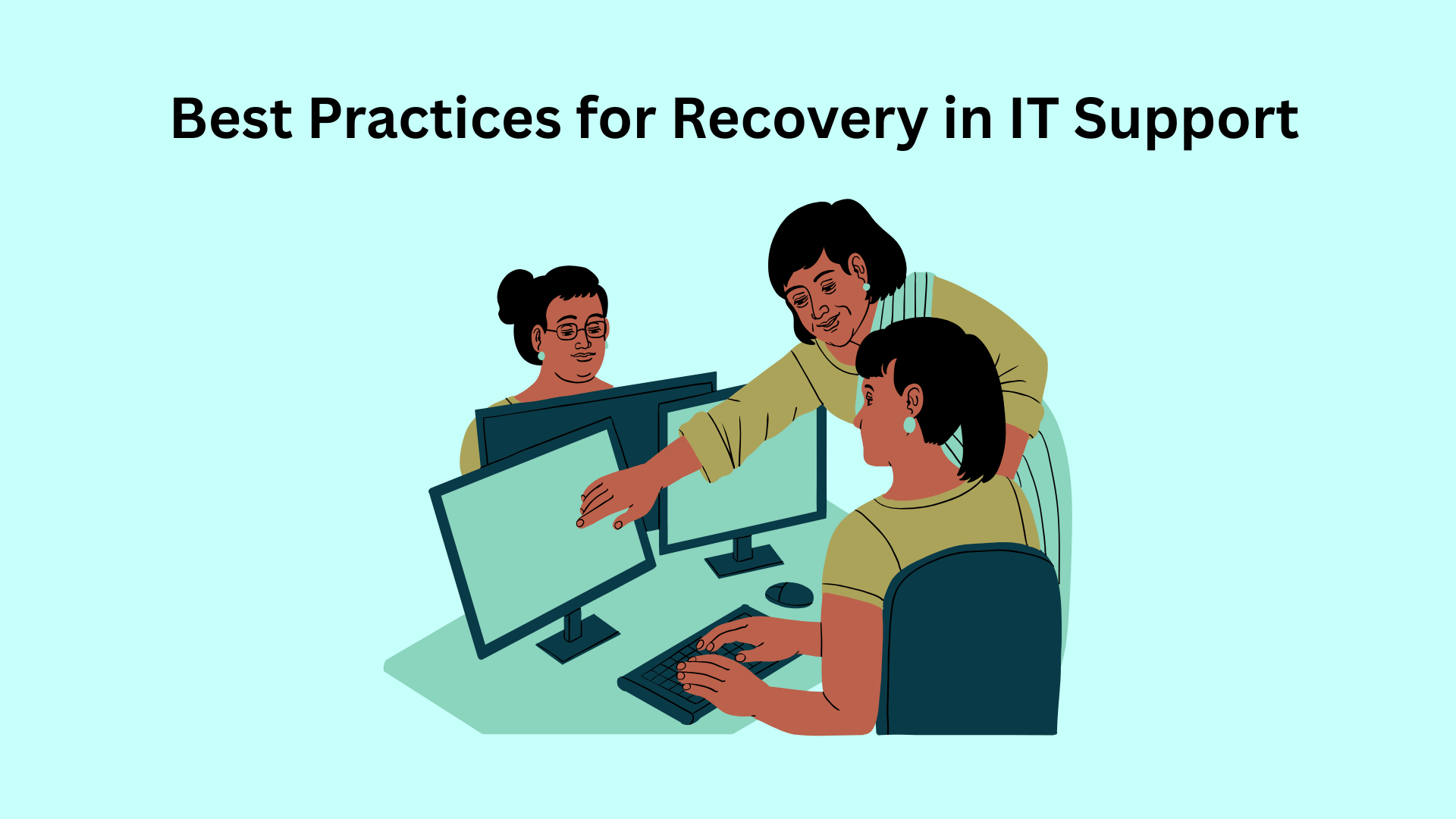How IT Support Contributes to Business Continuity Planning
No one wants their business to come to a standstill, but unexpected problems can arise at any moment.
Cyberattacks, system failures, or natural disasters can disrupt operations significantly.
These issues don’t just hinder workflows; they consume resources and challenge customer trust.
Did you know that 93% of companies without a solid disaster recovery plan close down after a major data loss?
That’s why having a robust business continuity plan is essential.
IT support plays a critical role in ensuring your company operates smoothly, regardless of the challenges.
This guide will explain how IT support safeguards your systems, enhances your security, and prepares you for unforeseen events.
Your business deserves to remain resilient.
Let’s take a closer look at how.
The Role of IT Support in Business Continuity Planning
IT support identifies weaknesses and builds plans to minimize risks. It keeps systems running smoothly during unexpected disruptions.
Identifying and Addressing Vulnerabilities
Identifying weak spots in your IT infrastructure reduces risks. Outdated software, unpatched systems, or unchecked access points open the door to threats.
Regular audits and vulnerability assessments highlight these blind spots, preventing small issues from escalating into disasters.
"Small cracks in security can sink even the strongest ship."
Quick action is key when flaws emerge. Strengthening firewalls, applying timely updates, and limiting unauthorized access enhance operational resilience.
Many businesses rely on technology management by Inspirica to conduct continuous monitoring, close security gaps efficiently, and maintain a proactive defense posture that supports long-term continuity.
Preventive steps today save you from downtime tomorrow.
Developing and Implementing Disaster Recovery Plans
Disaster recovery plans act as a safety net for businesses. A well-crafted plan minimizes downtime and protects critical operations during a crisis.
1. Conduct a business impact analysis to identify priority systems. Focus on applications and data that are essential for daily operations.
2. Outline clear steps for recovery after potential disruptions. Map out how to resume services quickly with order and clarity.
3. Create recovery time objectives for each system or service. Set specific timelines for restoring operations based on urgency.
4. Test the disaster recovery plan regularly with realistic simulations. Look for gaps or delays in response processes.
5. Use cloud-based solutions for secure data backups. Cloud systems offer adaptability and quicker retrieval compared to on-site storage.
6. Establish a communication flow for emergencies. Assign roles to team members to maintain clarity during incidents.
7. Document the recovery plan in detail. Make it accessible to key staff and review it frequently to stay updated with technology.
8. Train employees on their roles during recovery situations. Familiarity with the plan ensures smoother execution when disasters occur.
9. Partner with IT support teams to monitor emerging risks. Threats like ransomware or system failures require constant attention.
10. Review and improve the plan after every test or incident. Continuous adjustments strengthen operational resilience over time. Partnering with EMPIGO, an MSP, helps businesses implement disaster recovery frameworks that combine automation, data protection, and quick response strategies—key ingredients for uninterrupted operations during crises.
Strengthening Cybersecurity for Business Continuity
Cybersecurity serves as a safeguard, defending operations from threats that can hinder progress. IT teams work diligently to keep malicious actors out and your systems secure.
Threat Detection and Incident Response

Identifying threats early safeguards your business from cyberattacks. IT support teams observe systems continuously to detect unusual activity promptly. Swift actions minimize harm, reduce downtime, and maintain steady operations. "An ounce of prevention is worth a pound of cure."
Incident response plans direct teams during breaches. These plans describe precise steps to address issues quickly. This stops minor problems from escalating into significant disruptions.
Security Protocols and Compliance
Strong security measures protect businesses from cyber threats. IT support introduces protocols like multi-factor authentication and firewalls to safeguard sensitive data.
Regular software updates address vulnerabilities that hackers could exploit.
Businesses must adhere to legal compliance standards such as GDPR or HIPAA, depending on their industry. Non-compliance risks lawsuits, fines, and damaged reputations.
IT teams perform regular audits to identify weak points in the system. They train staff on recognizing phishing scams and risky online behavior. Compliance also involves documenting procedures for future reference during inspections or breaches.
These actions keep companies prepared for unforeseen security challenges while maintaining trust with clients and partners.
Ensuring Data Backup and Recovery
A solid backup plan protects your business from data loss during crises. Quick recovery systems keep operations running without skipping a beat.
Backup Strategies and Tools
Backing up data protects businesses from losing critical information. IT support plays a vital role in creating effective backup plans and using reliable tools.
- Regularly schedule automated backups to save time and reduce human error. Frequent backups keep data current and minimize interruptions.
- Use cloud storage services for secure off-site backups. These platforms offer flexibility, increased capacity, and quick access during emergencies.
- Test backup systems consistently to confirm they function properly. Overlooked errors can result in lost files or delays during recovery.
- Encrypt sensitive data before storing it on any platform. Encryption protects confidential information from breaches.
- Retain multiple copies of backups in different locations to counter physical damage, theft, or malware attacks.
- Train employees on backup procedures so they understand their role in securing business continuity.
This foundation ensures efficient recovery without risking prolonged downtime or data loss--essential for operational stability.
Best Practices for Recovery

Effective recovery strategies safeguard your business after disruptions. Proper planning and quick action minimize downtime and protect vital operations.
1. Test recovery plans regularly. Simulated drills reveal flaws in current strategies and prepare teams for real scenarios.
2. Store backups in diverse locations. On-site and off-site options reduce the chance of total data loss.
3. Use cloud solutions for backup. Cloud platforms provide flexibility and quicker access to stored files.
4. Monitor recovery processes consistently. Timely checks ensure tools and systems are functioning well.
5. Prioritize critical systems first. Focus on restoring essential functions before addressing minor outages.
Strengthening remote work options can further enhance operational resilience.
Enhancing Remote Work Capabilities
Strong IT support keeps remote teams connected and productive. It builds secure and reliable systems for accessing work tools anytime, anywhere.
Secure System Access and Connectivity
IT support teams establish secure access for remote workers by implementing multi-factor authentication and virtual private networks. These tools act as digital locks, keeping sensitive company data safe from theft or breaches.
Businesses gain assurance knowing employees can connect to IT infrastructure without compromising operational stability.
They also monitor system performance in real time to prevent connectivity issues during critical operations. Reliable connections reduce downtime and keep workflows running efficiently.
By addressing risks like unauthorized logins or weak network points, they enhance continuity strategies and service availability for growing businesses.
Conclusion
Strong IT support keeps businesses running smoothly during storms.
It identifies risks, protects systems, and quickly fixes issues.
With reliable plans in place, companies stay on track no matter what.
Technology may change, but preparation ensures stability. Stay ready, stay steady.







